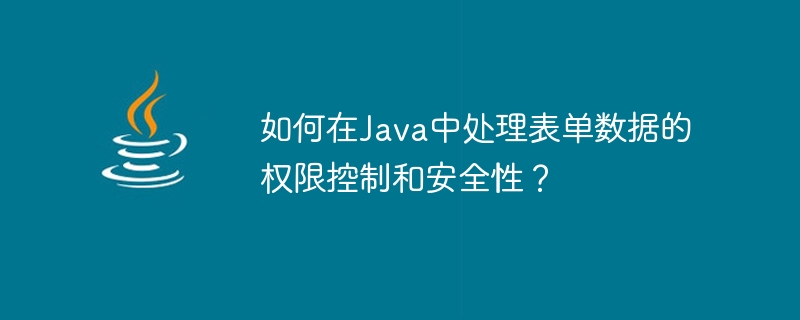
如何在Java中处理表单数据的权限控制和安全性?
在现代Web开发中,表单数据的处理是非常常见的任务。然而,由于表单数据可能涉及到用户的个人信息和敏感数据,因此必须采取适当的安全措施来保护用户的隐私和数据安全。本文将介绍如何在Java中处理表单数据的权限控制和安全性,并提供一些示例代码。
权限控制是确保只有授权用户可以访问和处理表单数据的关键。以下是一些常用的权限控制方法:
1.1 用户认证
在处理表单数据之前,首先需要验证用户的身份。用户认证可以通过用户名和密码、单点登录、令牌等方式实现。常见的Java认证框架有Spring Security、Shiro等。下面是一个使用Spring Security框架进行用户认证的示例:
@Configuration
@EnableWebSecurity
public class SecurityConfig extends WebSecurityConfigurerAdapter {
@Autowired
private UserDetailsService userDetailsService;
@Override
protected void configure(HttpSecurity http) throws Exception {
http
.authorizeRequests()
.antMatchers("/admin/**").hasRole("ADMIN")
.antMatchers("/user/**").hasAnyRole("ADMIN", "USER")
.anyRequest().authenticated()
.and()
.formLogin()
.loginPage("/login")
.permitAll()
.and()
.logout()
.permitAll();
}
@Autowired
public void configureGlobal(AuthenticationManagerBuilder auth) throws Exception {
auth.userDetailsService(userDetailsService).passwordEncoder(passwordEncoder());
}
@Bean
public PasswordEncoder passwordEncoder() {
return new BCryptPasswordEncoder();
}
}1.2 访问控制
除了用户认证外,还可以使用访问控制来限制不同用户对表单数据的访问权限。例如,管理员用户可以访问所有表单数据,而普通用户只能访问自己的数据。下面是一个使用Spring MVC框架进行访问控制的示例:
先定义一个表单数据实体类,例如UserForm:
public class UserForm {
private int id;
private String username;
// 其他字段...
// getters and setters
}然后在控制器中处理表单数据时,根据用户的角色和权限,进行相应的访问控制:
@Controller
public class UserController {
@Autowired
private UserService userService;
@GetMapping("/admin/users")
public String listAllUsers(Model model) {
List<UserForm> users = userService.getAllUsers();
model.addAttribute("users", users);
return "admin/user-list";
}
@GetMapping("/user/profile")
public String getUserProfile(Principal principal, Model model) {
String username = principal.getName();
UserForm user = userService.getUserByUsername(username);
model.addAttribute("user", user);
return "user/profile";
}
// 其他方法...
}安全性是确保表单数据在传输和存储过程中不被篡改或泄露的关键。以下是一些常用的表单数据安全性措施:
2.1 使用HTTPS协议
HTTPS协议能够保护表单数据在传输过程中的安全性,防止被中间人窃取或篡改。在使用Java进行Web开发时,可以通过使用SSL证书来启用HTTPS。示例如下:
@Configuration
public class WebSecurityConfig extends WebMvcConfigurerAdapter {
@Override
public void addInterceptors(InterceptorRegistry registry) {
registry.addInterceptor(new SSLInterceptor())
.addPathPatterns("/**")
.excludePathPatterns("/login", "/logout");
}
}
public class SSLInterceptor implements HandlerInterceptor {
@Override
public boolean preHandle(HttpServletRequest request, HttpServletResponse response, Object handler) throws Exception {
if (!request.isSecure()) {
String redirectUrl = request.getRequestURL().toString().replace("http://", "https://");
response.sendRedirect(redirectUrl);
return false;
}
return true;
}
}2.2 数据加密
对敏感数据进行加密可以进一步增强表单数据的安全性。例如,可以使用AES加密算法对用户密码进行加密,确保用户密码在传输和存储过程中不被泄露。示例如下:
public class EncryptionUtils {
private static final String SECRET_KEY = "MySecretKey";
public static String encrypt(String text) {
try {
Key key = new SecretKeySpec(SECRET_KEY.getBytes(), "AES");
Cipher cipher = Cipher.getInstance("AES");
cipher.init(Cipher.ENCRYPT_MODE, key);
byte[] encrypted = cipher.doFinal(text.getBytes());
return Base64.getEncoder().encodeToString(encrypted);
} catch (Exception ex) {
ex.printStackTrace();
}
return null;
}
public static String decrypt(String encryptedText) {
try {
Key key = new SecretKeySpec(SECRET_KEY.getBytes(), "AES");
Cipher cipher = Cipher.getInstance("AES");
cipher.init(Cipher.DECRYPT_MODE, key);
byte[] decrypted = cipher.doFinal(Base64.getDecoder().decode(encryptedText));
return new String(decrypted);
} catch (Exception ex) {
ex.printStackTrace();
}
return null;
}
}然后在处理表单数据时,可以使用该加密工具类对敏感数据进行加密和解密:
String password = "123456"; String encryptedPassword = EncryptionUtils.encrypt(password); String decryptedPassword = EncryptionUtils.decrypt(encryptedPassword);
总结:
在Java中处理表单数据的权限控制和安全性是Web开发中必不可少的一部分。通过合理使用用户认证、访问控制、HTTPS协议和数据加密等安全措施,可以确保表单数据的隐私和安全。同时,建议在实际开发中根据具体需求综合考虑并使用不同的安全技术来保护表单数据的安全性。
以上是如何在Java中处理表单数据的权限控制和安全性?的详细内容。更多信息请关注PHP中文网其他相关文章!




